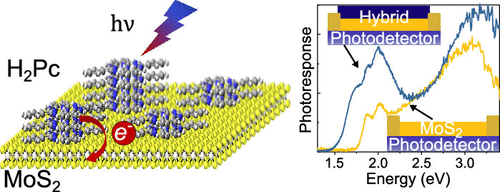当前位置:
X-MOL 学术
›
J. Phys. Chem. C
›
论文详情
Our official English website, www.x-mol.net, welcomes your
feedback! (Note: you will need to create a separate account there.)
Excited-State Charge Transfer Enabling MoS2/Phthalocyanine Photodetectors with Extended Spectral Sensitivity
The Journal of Physical Chemistry C ( IF 3.3 ) Pub Date : 2020-01-24 , DOI: 10.1021/acs.jpcc.9b10877 Niklas Mutz 1 , Soohyung Park 2, 3 , Thorsten Schultz 2, 4 , Sergey Sadofev 2 , Simon Dalgleish 1 , Louisa Reissig 5 , Norbert Koch 2, 4 , Emil J. W. List-Kratochvil 1 , Sylke Blumstengel 1
The Journal of Physical Chemistry C ( IF 3.3 ) Pub Date : 2020-01-24 , DOI: 10.1021/acs.jpcc.9b10877 Niklas Mutz 1 , Soohyung Park 2, 3 , Thorsten Schultz 2, 4 , Sergey Sadofev 2 , Simon Dalgleish 1 , Louisa Reissig 5 , Norbert Koch 2, 4 , Emil J. W. List-Kratochvil 1 , Sylke Blumstengel 1
Affiliation

|
Monolayer (ML) transition-metal dichalcogenides (TMDCs) are an attracting new class of two-dimensional direct band gap semiconducting materials for optoelectronic device applications. The combination of TMDCs with organic semiconductors holds the promise to further improve device properties with added functionality. Here, we demonstrate that excited-state charge transfer from a thin organic absorber layer, i.e., metal-free phthalocyanine (H2Pc), enhances the photoresponse of ML MoS2 dramatically at the same time also significantly extending it to spectral regions where the TMDC is transparent. The fundamental processes enabling this boost in photodetector performance are unraveled by a combination of photoemission (PES), photoluminescence (PL), and photocurrent action spectroscopy. Direct and inverse PES reveal a type II energy level alignment at the MoS2/H2Pc interface with a large energy offset of 1 eV, which is sufficient to drive the excited-state charge transfer. Time-resolved PL measurements evidence highly efficient dissociation of excitons generated in H2Pc when they are in contact with MoS2. Exciton dissociation results in the formation of a charge-separated state at the hybrid interface with an energy gap of ca. 1.2 eV, in accordance with PES. This state then dissociates into free carriers and markedly contributes to the current in the photodetector, as demonstrated by photocurrent action spectroscopy. This reveals that the photoconductivity within the MoS2 ML is generated by light directly absorbed in the TMDC and, notably, with comparable efficiency by the absorption by H2Pc. The present demonstration of a highly efficient carrier generation in TMDC/organic hybrid structures paves the way for future nanoscale photodetectors with very wide spectral sensitivity.
中文翻译:

激发态电荷转移,使MoS 2 /酞菁光电探测器具有更高的光谱灵敏度
单层(ML)过渡金属二卤化物(TMDC)是一种吸引人的新型二维直接带隙半导体材料,用于光电器件应用。TMDC与有机半导体的结合有望通过附加功能进一步改善器件性能。在这里,我们证明了从薄的有机吸收层(即不含金属的酞菁(H 2 Pc))的激发态电荷转移增强了ML MoS 2的光响应同时显着地将其扩展到TMDC透明的光谱区域。光发射(PES),光致发光(PL)和光电流作用光谱学的结合未能阐明能够提高光检测器性能的基本过程。正向和反向PES显示MoS 2 / H 2 Pc界面处的II型能级对准,具有1 eV的大能量偏移,足以驱动激发态电荷转移。时间分辨的PL测量表明,当H 2 Pc与MoS 2接触时,它们中的激子能高效解离。激子离解导致杂化界面处形成电荷分离态,能隙为。符合PES的1.2 eV。然后,该状态解离为自由载流子,并显着贡献于光检测器中的电流,如通过光电流作用谱所证明的。这表明,MoS 2 ML内的光电导性是由TMDC中直接吸收的光产生的,尤其是通过H 2 Pc的吸收具有相当的效率。TMDC /有机杂化结构中高效载流子产生的当前证明为具有非常宽的光谱灵敏度的未来纳米级光电探测器铺平了道路。
更新日期:2020-01-24
中文翻译:

激发态电荷转移,使MoS 2 /酞菁光电探测器具有更高的光谱灵敏度
单层(ML)过渡金属二卤化物(TMDC)是一种吸引人的新型二维直接带隙半导体材料,用于光电器件应用。TMDC与有机半导体的结合有望通过附加功能进一步改善器件性能。在这里,我们证明了从薄的有机吸收层(即不含金属的酞菁(H 2 Pc))的激发态电荷转移增强了ML MoS 2的光响应同时显着地将其扩展到TMDC透明的光谱区域。光发射(PES),光致发光(PL)和光电流作用光谱学的结合未能阐明能够提高光检测器性能的基本过程。正向和反向PES显示MoS 2 / H 2 Pc界面处的II型能级对准,具有1 eV的大能量偏移,足以驱动激发态电荷转移。时间分辨的PL测量表明,当H 2 Pc与MoS 2接触时,它们中的激子能高效解离。激子离解导致杂化界面处形成电荷分离态,能隙为。符合PES的1.2 eV。然后,该状态解离为自由载流子,并显着贡献于光检测器中的电流,如通过光电流作用谱所证明的。这表明,MoS 2 ML内的光电导性是由TMDC中直接吸收的光产生的,尤其是通过H 2 Pc的吸收具有相当的效率。TMDC /有机杂化结构中高效载流子产生的当前证明为具有非常宽的光谱灵敏度的未来纳米级光电探测器铺平了道路。










































 京公网安备 11010802027423号
京公网安备 11010802027423号